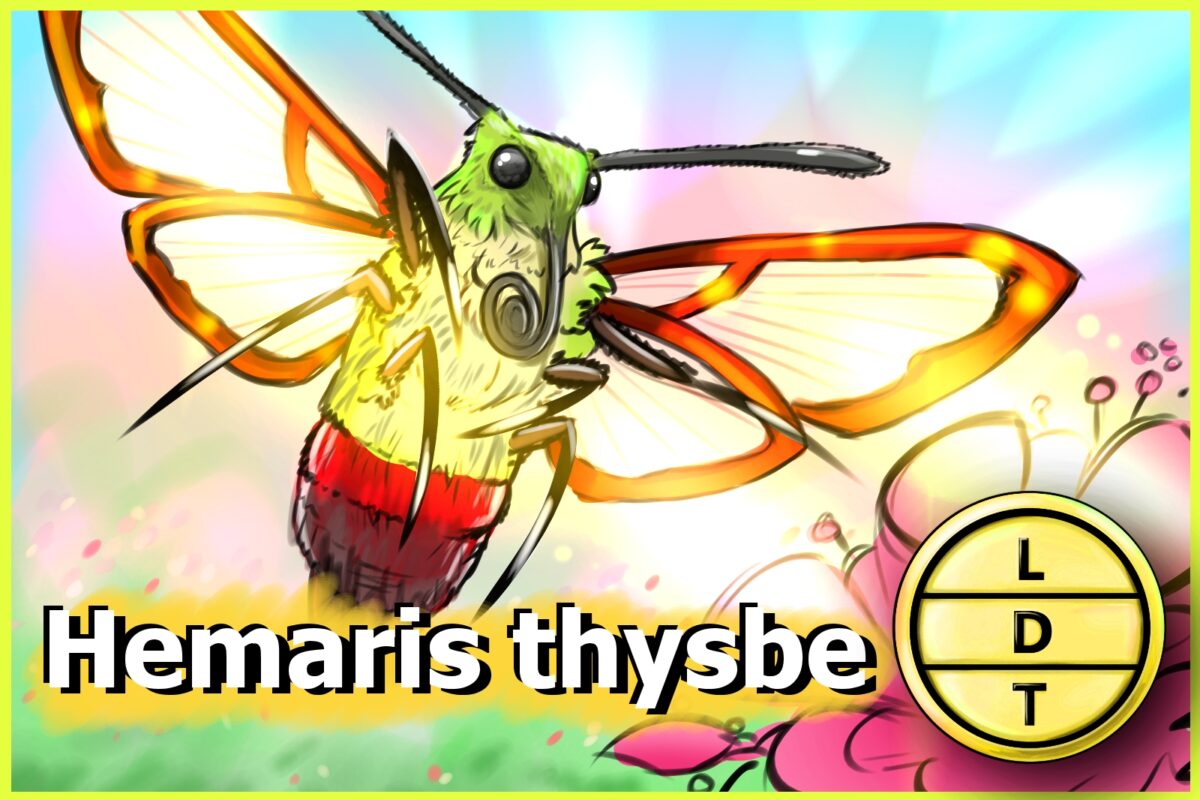“…and today we’re talking about an animal that I could have sworn we did before but I can’t find it in our list!”
Avoiding becoming someone else’s meal is typically priority number one for most animals. While there are many different ways to live another day in the “eat or be eaten” kingdom of Animalia, those that use disguises are sometimes the most interesting. One large moth thinks this whole disguise thing has gone to the birds. But you gotta do what you gotta do to sip that nectar here in Life, Death, and Taxonomy.
Description of the Hummingbird Moth
Hummingbird moths come in several colors but they’re usually a shade of green with a reddish color on their back. They may also have shades of yellow or white on their bellies.
Hummingbird moths have a large body compared to their wingsize, which is the opposite for most moths and butterflies. They also have two large antennas that look like bunny ears because they’re covered in black, hair-like chitinous fibers.
Hummingbird moths have a long proboscis that curls in flight and extends to suck up nectar.
Measure Up
Welcome to the beloved Measure Up segment. The official listener’s favorite part of the show! The part of the show when we present the animal’s size and dimension in relatable terms through a quiz that’s fun for the whole family. It’s also the part of the show that’s introduced by you when you send in audio of yourself saying, singing, or chittering the words measure up into ldtaxonomy at gmail dot com. We don’t have a Measure Up intro this week, which means we get to hear from an animal and Carlos has to guess what it is.
- Common kestrel
- Northern Goshawk
- Red Kite
- Sparrow Hawk
Wingspan
- 4 to 5.5 centimetres (1.6 to 2.2 in)
- How many clearwing hummingbirds go into the most expensive plane ever built?
- Hint: The B2 Spirit Stealth Bomber is the most expensive plane at $2.1 billion. It was built to beat anti-aircraft defenses through stealthiness.
- 938 moths. The bomber has a wingspan of 172 feet.
Proboscis length
- 19–21 millimetres (0.75–0.83 in)
- How many hummingbird moth proboscises go into the length of the longest straw chain?
- Hint: The longest straw chain was made by 27 students, including Petru Pogonaru and Marcu Cristi in Buzau, Romania in 2008.
- 535,907 proboscises. The chain was 11,298 m (37,066 ft 10 in) and included 58,469 straws.
Fast Facts about the Hummingbird Moth
Hummingbird moths can be found all over the world, but this particular species is native to the Americas. It’s a migratory moth that can be found all over including Alaska, Ontario, Texas and everywhere in between.
It likes to hang out in meadows, forest edges, and even suburban gardens. They tend to follow the flowers, looking for that sweet sweet nectar.
Moths lay their eggs on plants that hatch into hornworms, which are fairly famous in their own right. They are green with a little flexible spine on their butts. While their parents are welcome in gardens, the kids are considered pests and are known to feed on crops like tomatoes.
When the hungry hungry caterpillar gets full, they pupate in a pile of leaf litter, with the tardigrades whispering sweet dreams of air travel. When they emerge, they have a few weeks to eat nectar, breed, and lay eggs before they die.
Major Fact: Float Like a Butterfly, Sit Like a Bird
You may not have gathered it from Joe’s description, but when you look at this moth, especially from a distance, it looks a lot like a hummingbird.
Needless to say, being mistaken for a bird goes a long way toward not getting eaten by birds
The key to the illusion is doing what hummingbirds do. Flying around and sipping nectar from flowers comes naturally to most moths, but it’s coming out during the day that seems very un-mothy-like. This makes it pretty vulnerable to birds and other predators that hunt during the day.
But they also have another key factor – their clear wings.A typical hummingbird beats its wings about 70 times a second or 4,000 times per minute, which is why its wings appear invisible. The hummingbird moth can do the same, but trouble comes when it stops flapping.
But predators that are used to seeing hummingbirds as little feathered torsos floating around flowers without wings will see right through the disguise of the moth if the wings are visible when the moth is perched.
That’s why it has mostly clear wings. That way, by flapping its wings normally, and even by not flapping and just resting on a flower, it can maintain the appearance of being a hummingbird beating its wings 4,000 times a minute.
The piece de resistance is the fact that it can emit a hum that’s similar to a hummingbird’s when it flaps its wings.
If you’re in a garden and you see an exceptionally small hummingbird darting from flower to flower, you’re probably looking at a hummingbird moth.
Ending: So put on your best disguise, keep your wings a-flappin, and don’t forget about your proboscis whenever you’re sipping some nectar like the hummingbird moth here in LDT.

